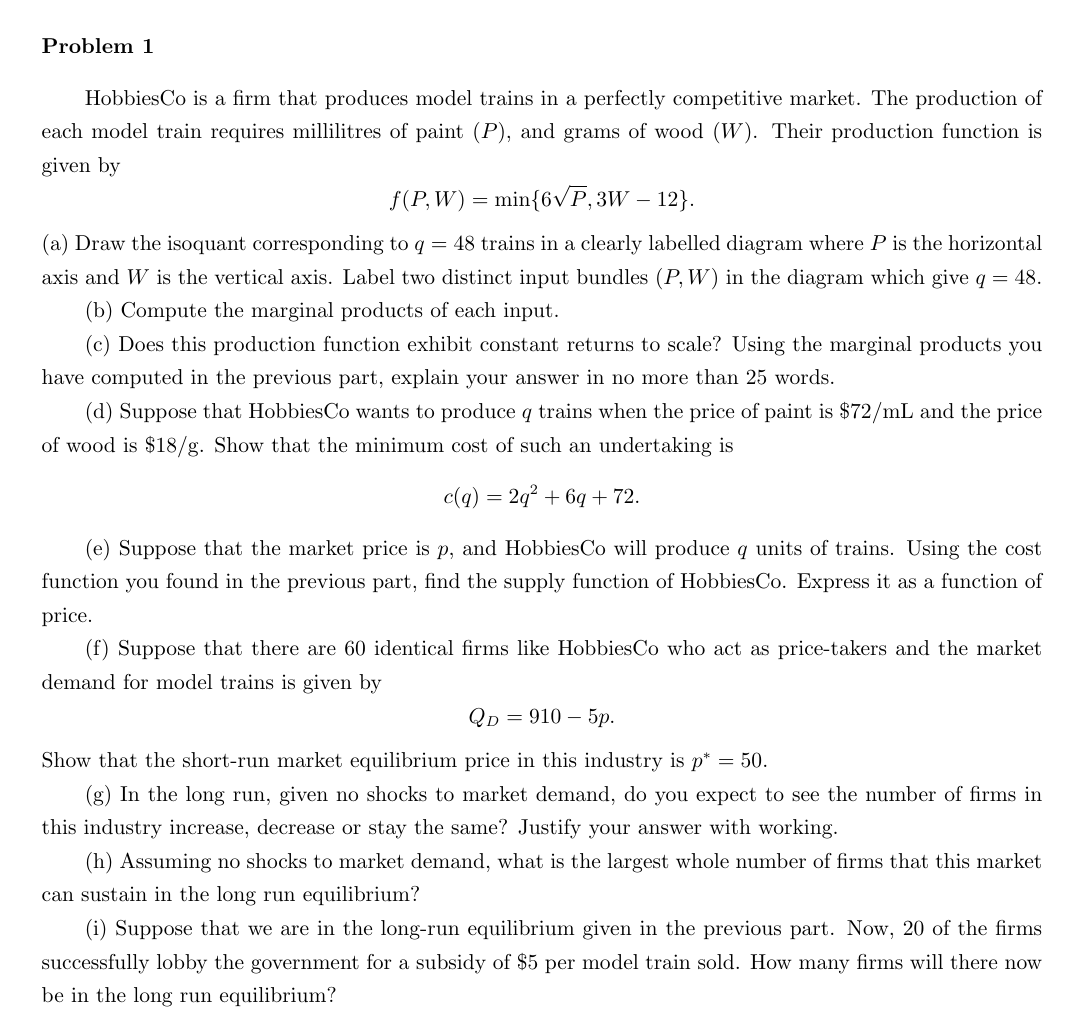(b) Compute the marginal products of each input. (c) Does this production function exhibit constant returns to scale? Using the marginal products you have computed in the previous part, explain your answer in no more than 25 words. (d) Suppose that Hobbies Co wants to produce q trains when the price of paint is $72/mL and the price of wood is $18/g. Show that the minimum cost of such an undertaking is c(q) = 2q² +6q+72. (e) Suppose that the market price is p, and Hobbies Co will produce q units of trains. Using the cost function you found in the previous part, find the supply function of Hobbies Co. Express it as a function of price. (f) Suppose that there are 60 identical firms like HobbiesCo who act as price-takers and the market demand for model trains is given by QD = 910 - 5p. Show that the short-run market equilibrium price in this industry is p* = 50. (g) In the long run, given no shocks to market demand, do you expect to see the number of firms in this industry increase, decrease or stay the same? Justify your answer with working. (h) Assuming no shocks to market demand, what is the largest whole number of firms that this market can sustain in the long run equilibrium? (i) Suppose that we are in the long-run equilibrium given in the previous part. Now, 20 of the firms successfully lobby the government for a subsidy of $5 per model train sold. How many firms will there now be in the long run equilibrium?
(b) Compute the marginal products of each input. (c) Does this production function exhibit constant returns to scale? Using the marginal products you have computed in the previous part, explain your answer in no more than 25 words. (d) Suppose that Hobbies Co wants to produce q trains when the price of paint is $72/mL and the price of wood is $18/g. Show that the minimum cost of such an undertaking is c(q) = 2q² +6q+72. (e) Suppose that the market price is p, and Hobbies Co will produce q units of trains. Using the cost function you found in the previous part, find the supply function of Hobbies Co. Express it as a function of price. (f) Suppose that there are 60 identical firms like HobbiesCo who act as price-takers and the market demand for model trains is given by QD = 910 - 5p. Show that the short-run market equilibrium price in this industry is p* = 50. (g) In the long run, given no shocks to market demand, do you expect to see the number of firms in this industry increase, decrease or stay the same? Justify your answer with working. (h) Assuming no shocks to market demand, what is the largest whole number of firms that this market can sustain in the long run equilibrium? (i) Suppose that we are in the long-run equilibrium given in the previous part. Now, 20 of the firms successfully lobby the government for a subsidy of $5 per model train sold. How many firms will there now be in the long run equilibrium?
Chapter9: Production Functions
Section: Chapter Questions
Problem 9.10P
Related questions
Question

Transcribed Image Text:Problem 1
Hobbies Co is a firm that produces model trains in a perfectly competitive market. The production of
each model train requires millilitres of paint (P), and grams of wood (W). Their production function is
given by
f(P,W)= min{6√P, 3W – 12}.
(a) Draw the isoquant corresponding to q = 48 trains in a clearly labelled diagram where P is the horizontal
axis and W is the vertical axis. Label two distinct input bundles (P, W) in the diagram which give q = 48.
(b) Compute the marginal products of each input.
(c) Does this production function exhibit constant returns to scale? Using the marginal products you
have computed in the previous part, explain your answer in no more than 25 words.
(d) Suppose that HobbiesCo wants to produce q trains when the price of paint is $72/mL and the price
of wood is $18/g. Show that the minimum cost of such an undertaking is
c(q) = 2q² +6q+72.
(e) Suppose that the market price is p, and Hobbies Co will produce q units of trains. Using the cost
function you found in the previous part, find the supply function of Hobbies Co. Express it as a function of
price.
(f) Suppose that there are 60 identical firms like Hobbies Co who act as price-takers and the market
demand for model trains is given by
QD 910 5p.
Show that the short-run market equilibrium price in this industry is p* = 50.
(g) In the long run, given no shocks to market demand, do you expect to see the number of firms in
this industry increase, decrease or stay the same? Justify your answer with working.
(h) Assuming no shocks to market demand, what is the largest whole number of firms that this market
can sustain in the long run equilibrium?
(i) Suppose that we are in the long-run equilibrium given in the previous part. Now, 20 of the firms
successfully lobby the government for a subsidy of $5 per model train sold. How many firms will there now
be in the long run equilibrium?
Expert Solution
This question has been solved!
Explore an expertly crafted, step-by-step solution for a thorough understanding of key concepts.
This is a popular solution!
Trending now
This is a popular solution!
Step by step
Solved in 3 steps

Knowledge Booster
Learn more about
Need a deep-dive on the concept behind this application? Look no further. Learn more about this topic, economics and related others by exploring similar questions and additional content below.Recommended textbooks for you







Exploring Economics
Economics
ISBN:
9781544336329
Author:
Robert L. Sexton
Publisher:
SAGE Publications, Inc

Principles of Economics 2e
Economics
ISBN:
9781947172364
Author:
Steven A. Greenlaw; David Shapiro
Publisher:
OpenStax
